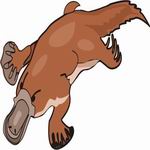- The head, trunk, and tail of the platypus are broad and flattened
and covered with thick dark brown fur.
- The muzzle is shaped like a duck's bill and is soft and rubbery.
- It contains ridges used for crushing food; the animal has no teeth.
- The eyes are small and there are no external ears.
- The five-toed feet are webbed.
- The adult male platypus is about 2 ft (60 cm) long, including the
5 or 6 in. (13-15 cm) tail; it weighs about 4 lb. The female is slightly
smaller.
- The platypus is found from tropical swamps at sea level to cold lakes
at altitudes of 6,000 ft (1,830 m). Its diet consists entirely of small
freshwater animals dredged from muddy bottoms.
- Prey captured underwater are stored in cheek pouches and eaten at
the surface or on land.
- Platypuses live in pairs in simple burrows in stream banks, except
during the breeding season, when the female makes a separate and more
elaborate burrow containing a nesting chamber approached by a long tunnel.
- One, two, or three eggs are laid at a time and are incubated, in
birdlike fashion, by the female. Geographic Range
- The platypus lives only in the freshwater systems of eastern Australia.
Observations in Queensland, New South Wales, Victoria and Tasmania,
suggest that they are abundant.
- They are found in water with temperatures varying from 25 -29.9 degrees
Celsius
|


